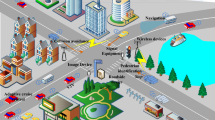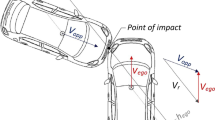Abstract
Driving strategy in dynamic environment is crucial to the automated vehicle safety. In extremely emergency scenarios with unavoidable collision (UC), especially those with complex impact patterns, the potential crash risk should be well considered. This paper proposes a crash mitigation (CM) algorithm for UCs, which directly embeds a generalized crash severity index (CSI) model to vehicle-to-vehicle collisions of multiple impact patterns. The idea is that during the short time before a collision, the vehicle will actively adapt its position and poses to minimize the potential crash severity level after the collision. To this end, the generalized CSI model is introduced to estimate the potential crash severity of all sample paths, from which a crash-severity-optimal trajectory is obtained. To improve the inferring time efficiency of the planning module, a neural network is constructed and deployed to approximate the nonlinear severity model. The proposed algorithm is first validated through simulations of UC scenarios, including entry ramp merging, intersection crossing and downhill/uphill crossing. Then for the intersection crossing scenario, the algorithm is deployed to a real car and validated through digital-twin experiments. Results show that by combining the braking and steering interventions for better crash severity reduction, the proposed strategy can achieve better mitigation effects than commonly used collision avoidance (CA) strategies. This reveals that a new mindset of comprehensive safety strategy should not focus only on CA, but also the last resort of CM if collision is unavoidable. Our work may contribute as a promising solution to the safety problem in emergency scenarios.















Similar content being viewed by others
Abbreviations
- AI:
-
Artificial intelligence
- ADAS:
-
Advanced driving assist system
- AEB:
-
Automated emergency braking
- AES:
-
Automated emergency steering
- C.G:
-
Center of gravity
- CA:
-
Collision avoidance
- CM:
-
Crash mitigation
- CMI:
-
Crash momentum index
- CSI:
-
Crash severity index
- DOF:
-
Degrees of freedom
- EES:
-
Equivalent energy speed
- FEM:
-
Finite element method
- IPC:
-
Industrial personal computer
- MPC:
-
Model predictive control
- PDOF:
-
Principal direction of force
- POI:
-
Point of impact
- TTC:
-
Time to collision
- UC:
-
Unavoidable collision
References
AAA Foundation for Traffic Safety (2016) Prevalence of Self-reported aggressive driving behavior: United States, 2014 (Technical Report). Accessed 29 March 2022. https://aaafoundation.org/prevalence-self-reported-aggressive-driving-behavior-united-states-2014/
National Center for Statistics and Analysis (2021) Speeding: 2019 data (Traffic Safety Facts. Report No. DOT HS 813 194). Accessed 29 March 2022. https://crashstats.nhtsa.dot.gov/Api/Public/ViewPublication/813194
CATARC (2021) Tongji University, Baidu Apollo: Automated Vehicle Safety: a White Paper. Accessed 17 December 2021. https://www.catarc.ac.cn/detail/60575b618c8d43999bba0f78a20d91ff
González D, Pérez J, Milanés V, Nashashibi F (2015) A review of motion planning techniques for automated vehicles. IEEE Transact Intell Transport Syst 17(4):1135–1145
Schwarting W, Alonso-Mora J, Rus D (2018) Planning and decision-making for autonomous vehicles. Annu Rev Control, Robotics, Autonomou Syst 1:187–210
Claussmann L, Revilloud M, Gruyer D, Glaser S (2019) A review of motion planning for highway autonomous driving. IEEE Transact on Intell Transport Syst 21(5):1826–1848
Lee K, Kum D (2019) Collision avoidance/mitigation system: motion planning of autonomous vehicle via predictive occupancy map. IEEE Access 7:52846–52857
Shen D, Chen Y, Li L, Chien S, (2020) Collision-free path planning for automated vehicles risk assessment via predictive occupancy map. In, (2020) IEEE intelligent vehicles symposium (IV). IEEE
Feng S, Qian Y, Wang Y (2021) Collision avoidance method of autonomous vehicle based on improved artificial potential field algorithm. Proceed Institut Mech Eng, Part D: J Automob Eng 235(14):3416–3430
Flores-Aquino GO, Vasquez-Gomez JI, Gutierrez-Frias O (2022) Custom distribution for sampling-based motion planning. J Braz Soc Mech Sci Eng 44(3):1–15
Bulut V (2021) Path planning for autonomous ground vehicles based on quintic trigonometric bézier curve. J Braz Soc Mech Sci Eng 43(2):1–14
Wang H, Huang Y, Khajepour A, Zhang Y, Rasekhipour Y, Cao D (2019) Crash mitigation in motion planning for autonomous vehicles. IEEE Transact Intell Trans Syst 20(9):3313–3323
Khattar V, Eskandarian A (2020) Reactive online motion re-planning for crash mitigation in autonomous vehicles using bezier curve optimization. In: ASME international mechanical engineering congress and exposition, 84553, pp 07–07016. American Society of Mechanical Engineers
Qin Y, Hashemi E, Khajepour A (2021) Integrated crash avoidance and mitigation algorithm for autonomous vehicles. IEEE Transact Ind Infor 17(11):7246–7255
Simon B, Franke F, Riegl P, Gaull A, (2019) Motion planning for collision mitigation via fem-based crash severity maps. In, (2019) IEEE intelligent vehicles symposium (IV). IEEE
Parseh M, Asplund F, Svensson L, Sinz W, Tomasch E, Törngren M (2021) A data-driven method towards minimizing collision severity for highly automated vehicles. IEEE Transact Intell Vehic 6(4):723–735
Huang M (2002) Vehicle crash mechanics. CRC Press, Boca Raton, Florida
Kambhampati S, Davis L (1986) Multiresolution path planning for mobile robots. IEEE J Robotic Automat 2(3):135–145
Kuffner JJ, LaValle SM (2000) Rrt-connect: An efficient approach to single-query path planning. In: Proceedings 2000 ICRA. Millennium conference. IEEE international conference on robotics and automation. Symposia proceedings (Cat. No. 00CH37065), 2, pp 995–1001. IEEE
Guan Y, Yokoi K, Stasse O, Kheddar A (2005) On robotic trajectory planning using polynomial interpolations. In: 2005 IEEE international conference on robotics and biomimetics-ROBIO, pp 111–116. IEEE
Hoang H, Tran AK, Tran LNT, Le M-H, Tran D-T (2021) A shortest smooth-path motion planning for a mobile robot with nonholonomic constraints. In: 2021 international conference on system science and engineering (ICSSE), pp 145–150. IEEE
Reeds J, Shepp L (1990) Optimal paths for a car that goes both forwards and backwards. Pacific J Math 145(2):367–393
Berg F, Walz F, Bürkle H, Epple J (1998) Implications of velocity change delta-v and energy equivalent speed ees for injury mechanism assessment in various collision configura tions. In: Proc. IRCOBI Conf. on Biomechanics, Göteborg
Ji A, Levinson D (2020) An energy loss-based vehicular injury severity model. Accid Anal & Prev 146:105730
Paul M, Ghosh I (2021) Development of conflict severity index for safety evaluation of severe crash types at unsignalized intersections under mixed traffic. Safe Sci 144:105432
Vangi D (2014) Impact severity assessment in vehicle accidents. Int Jo Crashworthiness 19(6):576–587
Gulino M-S, Di Gangi L, Sortino A, Vangi D (2021) Injury risk assessment based on pre-crash variables: the role of closing velocity and impact eccentricity. Accid Anal & Prev 150:105864
Vangi D, Gulino M-S, Fiorentino A, Virga A (2019) Crash momentum index and closing velocity as crash severity index. Proceed Inst Mech Eng, Part D: J Automob Eng 233(13):3318–3326
Kusano KD, Gabler HC (2013) Automated crash notification: evaluation of in-vehicle principal direction of force estimations. Transport Res part C: Emerg Technol 32:116–128
Savova-Mratsenkova M, Djonev G (2019) Determining the values of the coefficient of restitution in the meanwhile of a crash between two vehicles. In: IOP conference series: materials science and engineering, vol. 618, pp 012058. IOP Publishing
Wang Y, Zheng H, Zong C, Guo H, Chen H (2020) Path-following control of autonomous ground vehicles using triple-step model predictive control. Sci Chin Inform Sci 63(10):1–3
Ministry of Transport of China (2014) Technical standards of highway engineering (JTGB01-2014)
Feng C (2021) Design of rural highway under the background of rural revitalization. J Guangdong Commun Polytech 20(4):1–6
Author information
Authors and Affiliations
Corresponding author
Ethics declarations
Author Contributions
Daofei Li and Zhaohan Hu contributed to the study conception and design. Vehicle modelling, crash severity modelling and planning algorithm were performed by Daofei Li and Zhaohan Hu. Control algorithm and simulation was done by Zhaohan Hu and Bin Xiao. Experiments, data collection and analysis were performed by Daofei Li, Zhaohan Hu, Jiajie Zhang and Bin Xiao. The first draft of the manuscript was written by Daofei Li and Zhaohan Hu, and all authors commented on previous versions of the manuscript. All authors read and approved the final manuscript.
Video Abstract
A video abstract is available via Youtube: https://youtu.be/VkN2wLd-Rw0.
Funding
The author(s) disclosed receipt of the following financial support for the research, authorship, and/or publication of this article: This work was supported by Department of Science and Technology of Zhejiang (No. 2022C01241).
Conflict of interest
The author(s) declared no potential conflicts of interest with respect to the research, authorship, and/or publication of this article.
Additional information
Tecnical Editor: Rogério Sales Gonçalves.
Publisher's Note
Springer Nature remains neutral with regard to jurisdictional claims in published maps and institutional affiliations.
Rights and permissions
Springer Nature or its licensor (e.g. a society or other partner) holds exclusive rights to this article under a publishing agreement with the author(s) or other rightsholder(s); author self-archiving of the accepted manuscript version of this article is solely governed by the terms of such publishing agreement and applicable law.
About this article
Cite this article
Li, D., Zhang, J., Xiao, B. et al. Vehicle crash mitigation strategy in unavoidable collision scenarios: focusing on motion planning by considering a generalized crash severity model. J Braz. Soc. Mech. Sci. Eng. 44, 581 (2022). https://doi.org/10.1007/s40430-022-03893-1
Received:
Accepted:
Published:
DOI: https://doi.org/10.1007/s40430-022-03893-1




